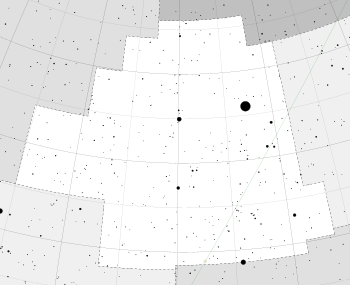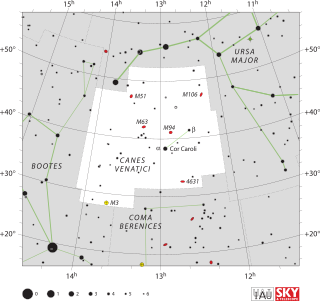
Cor Caroli is a binary star designated Alpha Canum Venaticorum or α Canum Venaticorum. The International Astronomical Union uses the name "Cor Caroli" specifically for the brighter star of the binary. Alpha Canum Venaticorum is the brightest point of light in the northern constellation of Canes Venatici.
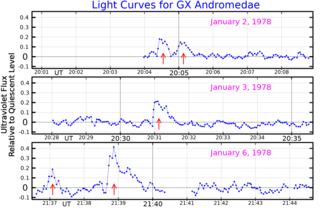
Groombridge 34 is a binary star system in the northern constellation of Andromeda. It was listed as entry number 34 in A Catalogue of Circumpolar Stars, published posthumously in 1838 by British astronomer Stephen Groombridge. Based upon parallax measurements taken by the Gaia spacecraft, the system is located about 11.6 light-years from the Sun. This positions the pair among the nearest stars to the Solar System.
Gliese 1 is a red dwarf in the constellation Sculptor, which is found in the southern celestial hemisphere. It is one of the closest stars to the Sun, at a distance of 14.2 light years. Because of its proximity to the Earth it is a frequent object of study and much is known about its physical properties and composition. However, with an apparent magnitude of about 8.6 it is too faint to be seen with the naked eye.
Gliese 674(GJ 674) is a small red dwarf star with an exoplanetary companion in the southern constellation of Ara. It is too faint to be visible to the naked eye, having an apparent visual magnitude of 9.38 and an absolute magnitude of 11.09. The system is located at a distance of 14.8 light-years from the Sun based on parallax measurements, but is drifting closer with a radial velocity of −2.9 km/s. It is a candidate member of the 200 million year old Castor stream of co-moving stars.

Gliese 105 is a triple star system in the constellation of Cetus. It is located relatively near the Sun at a distance of 23.6 light-years. Despite this, even the brightest component is barely visible with the unaided eye (see Bortle scale). No planets have yet been detected around any of the stars in this system.

Tau4 Eridani is a binary star system in the constellation Eridanus. It is visible to the naked eye with an apparent visual magnitude of 3.65. The distance to this star can be estimated using the parallax method, which yields a value of roughly 300 light years.
Gliese 412 is a pair of stars that share a common proper motion through space and are thought to form a binary star system. The pair have an angular separation of 31.4″ at a position angle of 126.1°. They are located 15.8 light-years distant from the Sun in the constellation Ursa Major. Both components are relatively dim red dwarf stars.
4 Camelopardalis is a probable multiple star in the northern constellation of Camelopardalis, located 177 light years away from the Sun, based upon parallax. With a combined apparent visual magnitude of 5.29, it is visible to the naked eye as a faint, white-hued star. The pair have a relatively high proper motion, traversing the celestial sphere at an angular rate of 0.158″ per year. The system's proper motion makes it a candidate for membership in the IC 2391 supercluster. They are moving away from the Earth with a heliocentric radial velocity of 22.5 km/s.
HD 30442 is a solitary star in the northern circumpolar constellation Camelopardalis. It is faintly visible to the naked eye with an apparent magnitude of 5.47 and is estimated to be 403 light years away from the Solar System. The object has a heliocentric radial velocity of −37 km/s, indicating that it is drifting closer.
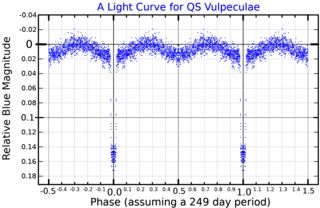
22 Vulpeculae is a binary star system in the northern constellation Vulpecula. Based on its parallax, it is located some 1,490 light-years away, and it has an apparent magnitude of about 5.2, making it visible to the naked eye. The system is moving closer to the Earth with a heliocentric radial velocity of −23 km/s.
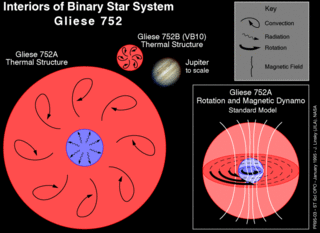
Gliese 752 is a binary star system in the Aquila constellation. This system is relatively nearby, at a distance of about 19 light years.

Stein 2051 is a nearby binary star system, containing a red dwarf and a degenerate star, located in constellation Camelopardalis at about 18 ly from Earth.

Epsilon Coronae Borealis, Latinized from ε Coronae Borealis, is a multiple star system in the constellation Corona Borealis located around 230 light-years from the Solar System. It shines with a combined apparent magnitude of 4.13, meaning it is visible to the unaided eye in all night skies except those brightly lit in inner city locations. It is an orange giant around 1.7 times as massive as the Sun of spectral type K2III, which has exhausted its core fuel supply of hydrogen and swollen to 21 times the Sun's diameter and 151 times its luminosity. That is, Epsilon Coronae Borealis's diameter is about one-quarter of Mercury's orbit. Its surface temperature has been calculated to be 4365 ± 9 K, or 4406 ± 15 K. It is thought to be around 1.74 billion years old.

Delta Sagittae is a binary star in the constellation of Sagitta, with an apparent magnitude of +3.68. The primary component is a red M-type bright giant, and the secondary is a B-type main-sequence star. It is approximately 430 light years from Earth, based on its Gaia Data Release 2 parallax.
Gliese 251, also known as HIP 33226 or HD 265866, is a star located about 18 light years away from the Solar System. Located in the constellation of Gemini, it is the nearest star in this constellation. It is located near the boundary with Auriga, 49 arcminutes away from the bright star Theta Geminorum; due to its apparent magnitude of +9.89 it cannot be observed with the naked eye. The closest star to Gliese 251 is QY Aurigae, which is located 3.5 light years away.

GL Virginis, also known as G 12-30, is a star in the constellation of Virgo. It is a faint red dwarf, like more than 70% of the stars located within 10 parsecs of the Solar System; its magnitude visual magnitude is 13.898, making it impossible to see with the naked eye.
HD 126053 is the Henry Draper Catalogue designation for a star in the equatorial constellation of Virgo. It has an apparent magnitude of 6.25, which means it is faintly visible to the naked eye. According to the Bortle scale, it requires dark suburban or rural skies to view. Parallax measurements made by the Hipparcos spacecraft provide an estimated distance of 57 light years to this star. It is drifting closer with a heliocentric radial velocity of −19.2 km/s.
HR 6594 is the Bright Star Catalogue designation for a binary star system in the northern constellation of Hercules. It is faintly visible to the naked eye with an apparent visual magnitude of 5.54; according to the Bortle scale, it is sufficiently bright to be visible from dark suburban skies. The distance to this system, as determined using parallax measurements, is about 114 light years. It is drifting closer with a heliocentric radial velocity of −43.7 km/s, and is predicted to come as near as 47 light-years in 686,000 years. On the celestial sphere it is located near the star Alpha Ophiuchi; their projected separation is just 3 light years, although their actual separation is much greater.

RS Canum Venaticorum is a binary star system in the northern constellation of Canes Venatici. It serves as the prototype to the class of RS Canum Venaticorum variables. The peak apparent visual magnitude of this system is below the level needed to observe it with the naked eye. It is located at a distance of approximately 443 light years from the Sun based on parallax, but is drifting closer with a net radial velocity of −14 km/s. Olin J. Eggen (1991) included this system as a member of the IC 2391 supercluster, but it was later excluded.

Gliese 569 is a ternary star system composed of a main-sequence star orbited by a pair of brown dwarfs in the constellation of Boötes about 32 light years away.

